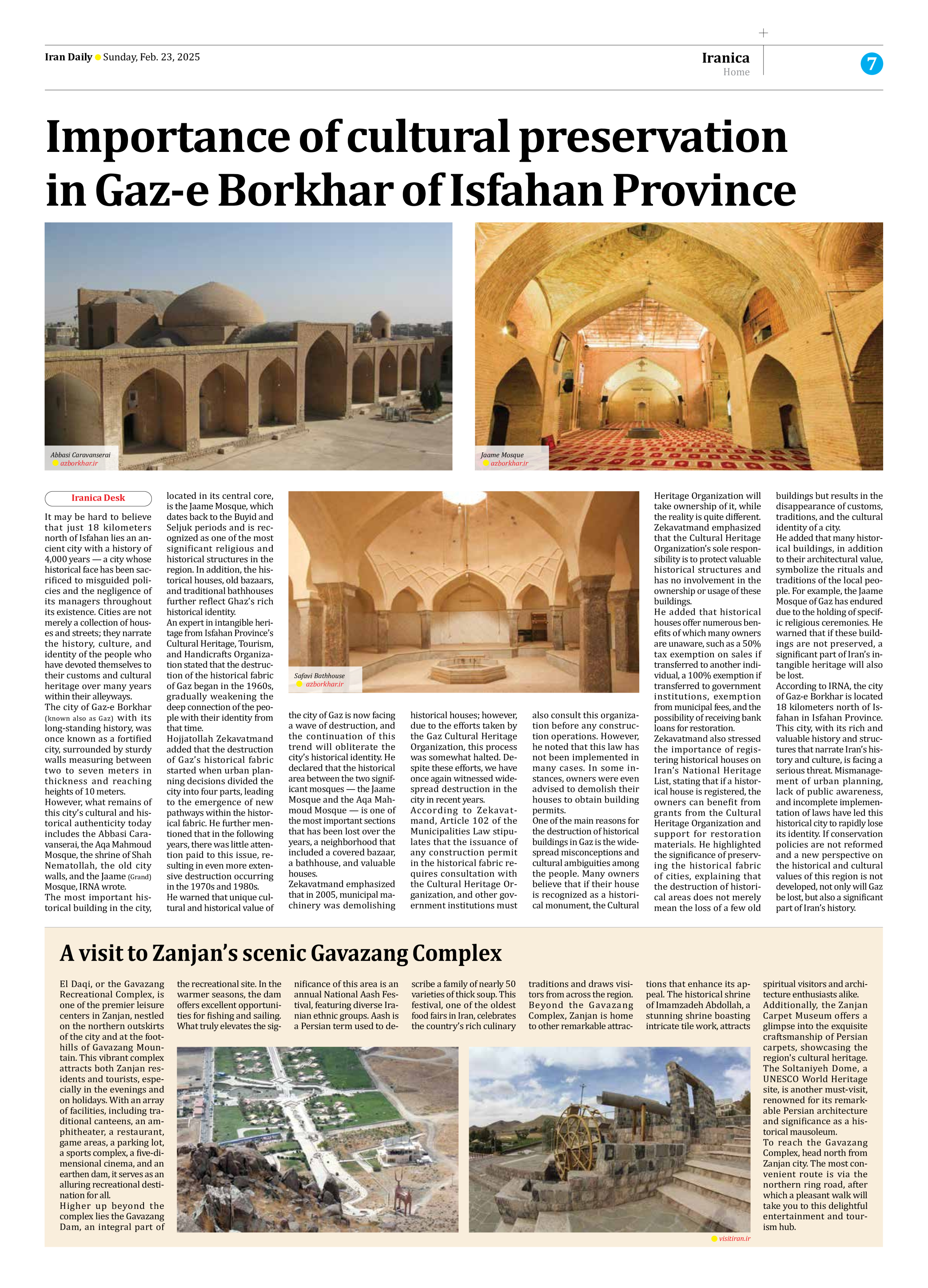
Importance of cultural preservation in Gaz-e Borkhar of Isfahan Province
It may be hard to believe that just 18 kilometers north of Isfahan lies an ancient city with a history of 4,000 years — a city whose historical face has been sacrificed to misguided policies and the negligence of its managers throughout its existence. Cities are not merely a collection of houses and streets; they narrate the history, culture, and identity of the people who have devoted themselves to their customs and cultural heritage over many years within their alleyways.
The city of Gaz-e Borkhar (known also as Gaz) with its long-standing history, was once known as a fortified city, surrounded by sturdy walls measuring between two to seven meters in thickness and reaching heights of 10 meters.
However, what remains of this city’s cultural and historical authenticity today includes the Abbasi Caravanserai, the Aqa Mahmoud Mosque, the shrine of Shah Nematollah, the old city walls, and the Jaame (Grand) Mosque, IRNA wrote.
The most important historical building in the city, located in its central core, is the Jaame Mosque, which dates back to the Buyid and Seljuk periods and is recognized as one of the most significant religious and historical structures in the region. In addition, the historical houses, old bazaars, and traditional bathhouses further reflect Ghaz’s rich historical identity.
An expert in intangible heritage from Isfahan Province’s Cultural Heritage, Tourism, and Handicrafts Organization stated that the destruction of the historical fabric of Gaz began in the 1960s, gradually weakening the deep connection of the people with their identity from that time.
Hojjatollah Zekavatmand added that the destruction of Gaz’s historical fabric started when urban planning decisions divided the city into four parts, leading to the emergence of new pathways within the historical fabric. He further mentioned that in the following years, there was little attention paid to this issue, resulting in even more extensive destruction occurring in the 1970s and 1980s.
He warned that unique cultural and historical value of the city of Gaz is now facing a wave of destruction, and the continuation of this trend will obliterate the city’s historical identity. He declared that the historical area between the two significant mosques — the Jaame Mosque and the Aqa Mahmoud Mosque — is one of the most important sections that has been lost over the years, a neighborhood that included a covered bazaar, a bathhouse, and valuable houses.
Zekavatmand emphasized that in 2005, municipal machinery was demolishing historical houses; however, due to the efforts taken by the Gaz Cultural Heritage Organization, this process was somewhat halted. Despite these efforts, we have once again witnessed widespread destruction in the city in recent years.
According to Zekavatmand, Article 102 of the Municipalities Law stipulates that the issuance of any construction permit in the historical fabric requires consultation with the Cultural Heritage Organization, and other government institutions must also consult this organization before any construction operations. However, he noted that this law has not been implemented in many cases. In some instances, owners were even advised to demolish their houses to obtain building permits.
One of the main reasons for the destruction of historical buildings in Gaz is the widespread misconceptions and cultural ambiguities among the people. Many owners believe that if their house is recognized as a historical monument, the Cultural Heritage Organization will take ownership of it, while the reality is quite different.
Zekavatmand emphasized that the Cultural Heritage Organization’s sole responsibility is to protect valuable historical structures and has no involvement in the ownership or usage of these buildings.
He added that historical houses offer numerous benefits of which many owners are unaware, such as a 50% tax exemption on sales if transferred to another individual, a 100% exemption if transferred to government institutions, exemption from municipal fees, and the possibility of receiving bank loans for restoration.
Zekavatmand also stressed the importance of registering historical houses on Iran’s National Heritage List, stating that if a historical house is registered, the owners can benefit from grants from the Cultural Heritage Organization and support for restoration materials. He highlighted the significance of preserving the historical fabric of cities, explaining that the destruction of historical areas does not merely mean the loss of a few old buildings but results in the disappearance of customs, traditions, and the cultural identity of a city.
He added that many historical buildings, in addition to their architectural value, symbolize the rituals and traditions of the local people. For example, the Jaame Mosque of Gaz has endured due to the holding of specific religious ceremonies. He warned that if these buildings are not preserved, a significant part of Iran’s intangible heritage will also be lost.
According to IRNA, the city of Gaz-e Borkhar is located 18 kilometers north of Isfahan in Isfahan Province. This city, with its rich and valuable history and structures that narrate Iran’s history and culture, is facing a serious threat. Mismanagement of urban planning, lack of public awareness, and incomplete implementation of laws have led this historical city to rapidly lose its identity. If conservation policies are not reformed and a new perspective on the historical and cultural values of this region is not developed, not only will Gaz be lost, but also a significant part of Iran’s history.







